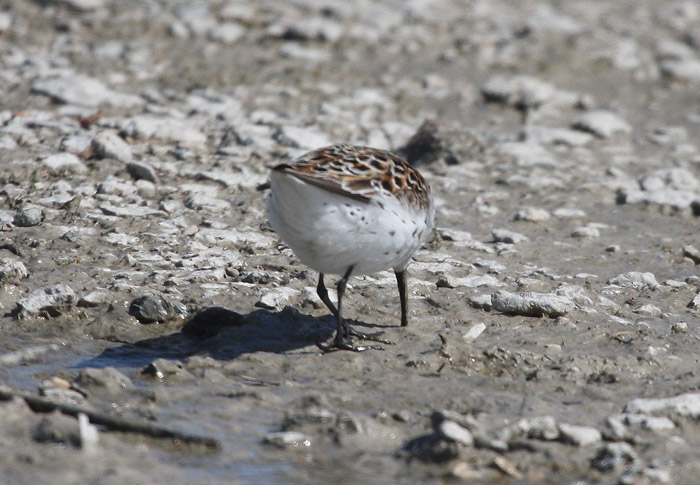Comments:
For this quiz we know the bird is a shorebird (if
it wasnít obvious in the photo I told you it was also). That is out
starting point. The position of the bird doesnít allow us to see the
head or breast, but we have still have enough good field marks to get
a positive ID.
The posture of this bird gives us a great look at
the legs so letís start there. Judging size can be tricky in photos,
but this bird appears to have relatively short, black legs. Some
plovers also may have black, short legs, but our bird has reddish
feathers on the back and a clean, white breast with spotting down the
side. That eliminates all the plovers.
That still leaves us with about 20 species to
choose from. The black legs alone eliminate a few species. The 2
Dowitchers, Ruddy Turnstone, Pectoral, Sharp-tailed, and Least
Sandpipers, and others all have yellow or greenish legs.
Now that we have narrowed the field, letís take a
closer look at other field marks. Many of you mentioned the bill. We
donít have a clear view of it, but it appears to be all black and a
little long. It also appears to be somewhat tapered and may turn down
a bit near the end. This probably pointed most of you toward a
Western Sandpiper, but bill length and shape is variable and even with
a good look can be a bit tricky. It is a good idea to look at other
field marks as well.
Given that, letís take a closer look at the
plumage. The bright colors on the back, the clean white breast with
crisp black spotting along the sides points to a bird in breeding
plumage. That helps Ė non-breeding are even trickier.
Looking closely at the plumage we can start
eliminating some species . A Sanderling doesnít have streaking down
the sides like this bird. The amount of red or rufous in the back
eliminates Bairdís and White-rumped Sandpipers. Even if this bird was
in a transitional stage and not in full breeding plumage a Red Knot
should show some rufous on the belly, and a Dunlin would show at least
some black. A closer look at the red feathers on the back would
eliminate both of these as well (see below).
Unless I am forgetting anything I think we are
left with Western Sandpiper and Semipalmated Sandpiper. Typically the
bill on a Semipalmated is shorter and straighter than a Western. As
mentioned above, our birdís bill looks like a that of a Western.
Semipalmated Sandpipers normally donít have as much red in the back
and normally show less streaking on the sides, but again this can be
somewhat variable. A close look at the reddish feathers on the back
are conclusive. The feathers on a Semipalmated are mostly black in
the center with a rufous edge. The Western Sandpiper has feathers
that are rufous at the base and center with black towards the end, all
of which is surrounded by a white edge (if you own Shorebirds: an
identification Guide it shows a drawing of this pattern on plate 75).
The angle of our photo shows gives us a great look at this pattern and
eliminates all doubt about our ID.
I photographed this WESTERN SANDPIPER on May 6,
2010 at Lincoln Beach, Utah.
|

